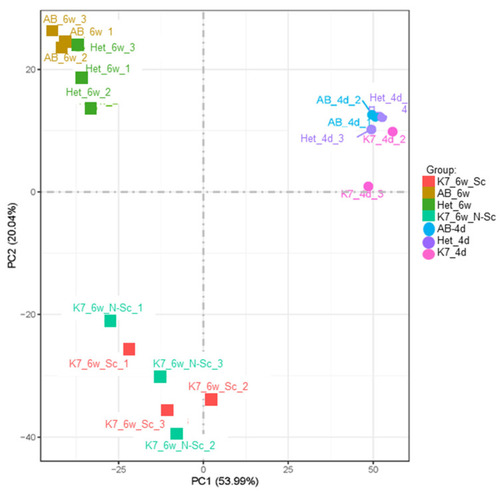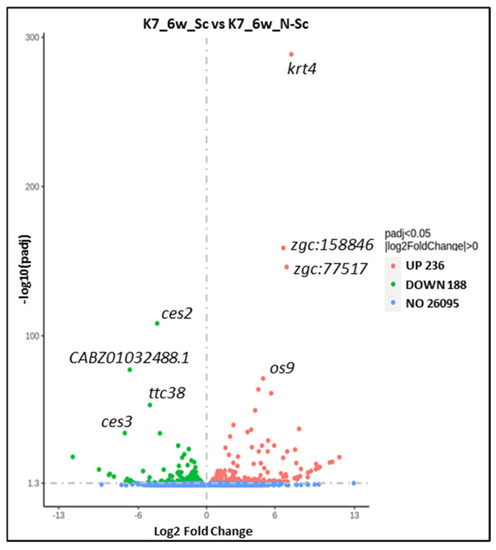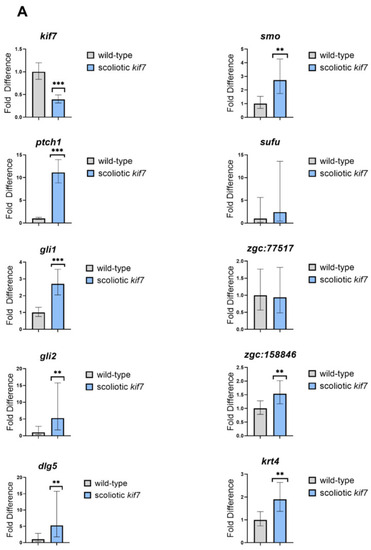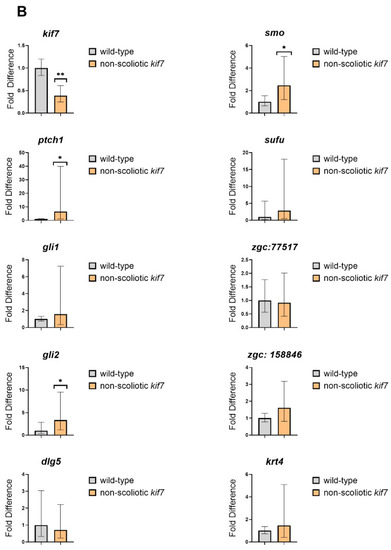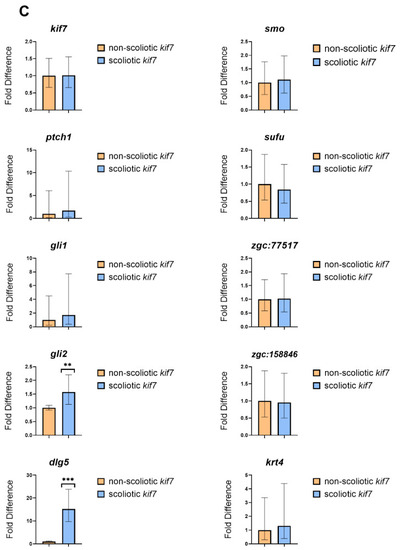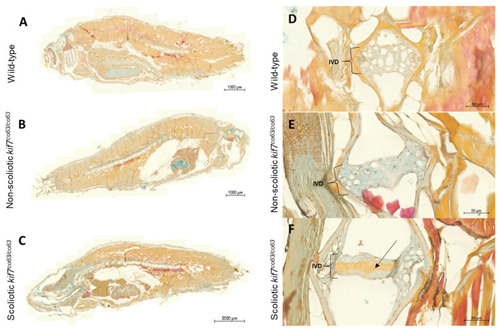- Title
-
Cytoskeletal Keratins Are Overexpressed in a Zebrafish Model of Idiopathic Scoliosis
- Authors
- Cuevas, M., Terhune, E., Wethey, C., James, M., Netsanet, R., Grofova, D., Monley, A., Hadley Miller, N.
- Source
- Full text @ Genes (Basel)
|
Approximately 25% of kif7co63/co63 zebrafish (D. rerio) show spinal curvatures, as indicated. The remaining zebrafish appear identical to wild type. Spinal curvature can be seen on the caudal part of the fish compared to wild type (A,C). Clear segmentation of vertebrae was observed in both wild-type (B) and scoliotic fish (D) as denoted by arrows. PHENOTYPE:
|
|
Principal Component Analysis (PCA) plot of all sequenced samples. 6 wpf (6w) kif7co63/co63 scoliotic (K7_6w_S), non-scoliotic (K7_6w_N-Sc), heterozygous (Het_6w) and AB (AB_6w) zebrafish (D. rerio) are shown, along with AB, heterozygous, and kif7co63/co63 embryonic zebrafish (4 dpf [4d]). |
|
Volcano plot of 6 wpf kif7co63/co63 scoliotic (S) vs. non-scoliotic (N-Sc) zebrafish (D. rerio). Each point represents a single transcript, and gene names are provided for the top four up- and downregulated transcripts. |
|
RT-qPCR of 6wpf zebrafish ( EXPRESSION / LABELING:
PHENOTYPE:
|
|
RT-qPCR of 6wpf zebrafish (D. rerio). Comparisons between wild-type and scoliotic kif7co63/co63 (A), wild-type and non-scoliotic kif7co63/co63 (B), and scoliotic kif7co63/co63 and non-scoliotic kif7co63/co63 (C) was performed for genes in the shh signaling pathway and the keratin genes observed in the RNA sequencing data. Error bars represent 95% confidence intervals. * indicates p < 0.05, ** indicates p < 0.01, and *** indicates p < 0.001. |
|
RT-qPCR of 6wpf zebrafish (D. rerio). Comparisons between wild-type and scoliotic kif7co63/co63 (A), wild-type and non-scoliotic kif7co63/co63 (B), and scoliotic kif7co63/co63 and non-scoliotic kif7co63/co63 (C) was performed for genes in the shh signaling pathway and the keratin genes observed in the RNA sequencing data. Error bars represent 95% confidence intervals. * indicates p < 0.05, ** indicates p < 0.01, and *** indicates p < 0.001. |
|
Keratin staining of wild-type (A,D), non-scoliotic (B,E), and scoliotic kif7co63/co63 (C,F) 6 wpf zebrafish (D. rerio). Keratin staining of whole cross section fish (A–C) and selective caudal vertebrae (D–F) depicting the intervertebral disk (IVD) are shown. The IVD is distinguished by vacuolated cells clearly in the wild-type and non-scoliotic kif7co63/co63 fish, but vacuolated cells are less visible in scoliotic kif7co63/co63. Blue: glycosaminoglycans; orange to red: prekeratin to keratin; brown: nuclei. Increased keratin/prekeratin can be seen in the IVD of scoliotic fish compared to non-scoliotic fish and wild type, as denoted by the black arrow. N = 3 zebrafish were analyzed for each group (wild type, scoliotic kif7co63/co63, and non-scoliotic kif7co63/co63). PHENOTYPE:
|


